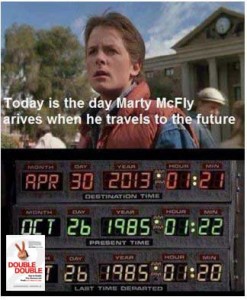
I’ve worked with a lot of young, ambitious entrepreneurs in my time as a business coach and mentor. They are a diverse group, from tech savvy Silicon Valley insiders to master sommeliers. They’ve wanted a lot of different things, from more press to a better corporate culture. But underneath it all, they’ve all really wanted the same thing: to make more money.
It’s a universal desire, and one that I can help them achieve. But to get there, they have to prepare for fast growth. And they’ll never get there without a detailed vision of their future.
This is why I am such a proponent of creating a Vivid Vision (formerly Painted Picture). It’s a detailed, three to four page document that lays out a clear, logical vision of what your company will look like in three years.
When completed, it’s meant to be woven into your company’s culture, guiding your employees decision making and giving all involved clear goals to strive for.
Usually, creating Vivid Visions is a very involved process that can take as long as six months to get right. There’s a lot of back and forth between my clients and me. Unfortunately, I don’t have the time to spend with each of you as you put together your own, but I can offer these tips that will help you get started down the right path in creating the very best Vivid Vision possible.
It’s important not to get caught up in the ‘how’ of things. Instead, dream big and worry about the ‘how’ later
You’ll need to be free of the day-to-day worries of running your business. You need freedom to visualize your future
Get out of your office and go somewhere inspiring where you can let your mind wander (I wrote the Vivid Vision for my business from the hammock in my backyard)
Turn off your computer. No matter how much willpower you have, the temptation of email or web surfing will be a distraction
Get out of your comfort zone, think out side the box—choose whatever cliché works for you. Just be creative, even outlandish. You’ll be amazed at what you can come up with. It’s a sure fire way to create a fun, dynamic vision you and your employees will love to strive for.
I’ve helped with dozens of Vivid Visions in my career, and the ones that really stand out in my mind share a few common traits. They forgo all the mind-numbing corporate double speak and restrictive, creativity-killing metrics and get right to the heart of the exercise:
“What is really possible for my company?”
Check out these advice where I talk in more detail about certain aspects of the Vivid Vision/Painted Picture process. You can also find a copy of my own Vivid Vision online at BackPocketCOO.com, To some, it is just a four page document. But to you, it very well may be the most important four pages you ever write. email me at Cameron@BackPocketCOO.com for coaching around doing your own.

 Remember when Marty McFly from the movie Back To The Future, got into a time machine and traveled into the future. He looked around at what he saw, then went back to his current day and told everyone what to expect down the road. They were excited.
Remember when Marty McFly from the movie Back To The Future, got into a time machine and traveled into the future. He looked around at what he saw, then went back to his current day and told everyone what to expect down the road. They were excited. 1. Get out of your office. When creating a Vivid Vision (formerly Painted Picture) for your company you must leave your office. If you sit at your desk or ‘hide’ in a boardroom, you’ll get dragged back into your typical routine and your mind can’t wander into the future. Working from an office tends to put specific constraints on your mind, and that’s the antithesis of this exercise. Forget current metrics, daily tasks and obligations, and the looming question of ‘how?’ and simply let your mind wander.
1. Get out of your office. When creating a Vivid Vision (formerly Painted Picture) for your company you must leave your office. If you sit at your desk or ‘hide’ in a boardroom, you’ll get dragged back into your typical routine and your mind can’t wander into the future. Working from an office tends to put specific constraints on your mind, and that’s the antithesis of this exercise. Forget current metrics, daily tasks and obligations, and the looming question of ‘how?’ and simply let your mind wander.



